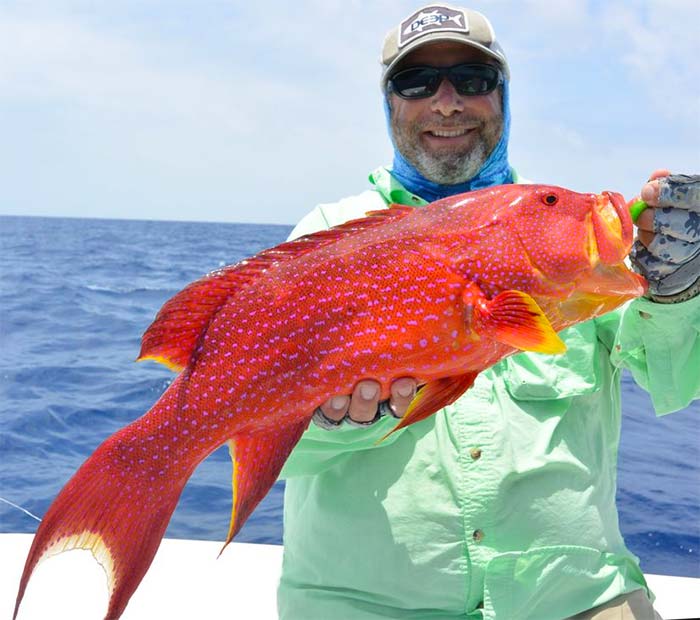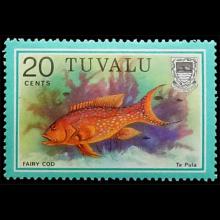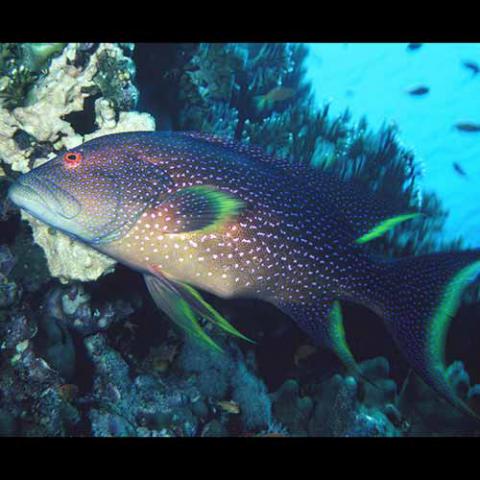NAMES
TAXONOMY
Tuvalu
Issued:
Stamp:
Variola louti
Tuvalu
Issued:
Stamp:
Variola louti
Tuvalu
Issued:
Stamp:
Variola louti
20 Fabulous Game Fish of the Great Barrier Reef
(excerpt)
Coronation Trout (Variola louti)

One of the most visually striking of the grouper family (Serranidae) is also one of the most common over Indo-Pacific shallow reefs. They're definitely not shy about grabbing any sort of lure. But no one Down Under refers to 'em by their official common name, the yellow-edged lyretail. Whatever you call it, the IGFA world record is 13 pounds, 14 ounces from Japan in 2013.Capt. Damon Olsen
Genus species (Animalia): Variola louti
The yellow-edged lyretail (Variola louti) also known as the yellowedge coronation trout, fairy cod, lunar tail rock cod, lunartailed cod, lyre-tail cod or moontail seabass,, is a species of marine ray-finned fish, a grouper from the subfamily Epinephelinae which is part of the family Serranidae, which also includes the anthias and sea basses. It is found in the Indo-Pacific region and is more common than the congeneric white-edged lyretail.
Description
The yellow-edged lyretail has an oblong-shaped body on which the length of the head is longer than the depth of the body, the standard length of its body is 2.8 to 3.3 times its depth. The preopercle is rounded with fine serrations along its edge with the lower edge being fleshy. There are three flat spines on the gill cover, which has a straight upper edge. The dorsal fin contains 9 spines and 13–14 soft rays while the anal fin contains 3 spines and 8 soft rays. The caudal fin is crescent-shaped with its upper and lower lobes extended and are around two times the length of the fin's middle rays.[2] The overall color of this grouper is reddish and it is covered in blue spots. The dorsal and anal fins have pointed posterior tips. They have a reddish color on the upper body which frequently shades to orangish to white on the lower part of the body. They are marked with many small bluish or pinkish spots on the head, body and fins. The rear margins of the fins are yellow. The juveniles appear to mimic goatfishes of the family Mullidae. This species attains a maximum recorded total length of 83 centimeters (33 in), although 75 centimeters (30 in) is a more normal length, and a maximum weight of 12 kilograms (26 lb).
Distribution
The yellow-edged lyretail is has an Indo-Pacific distribution and is found from the east coast of Africa where it occurs from Durban in South Africa to the Red Sea through the tropical Indian Ocean east into the Pacific Ocean where it occurs as far north as southern Japan, south to Australia and east to the Pitcairn Islands. In Australia it is found from Shark Bay in Western Australia to Ashmore Reef in the Timor Sea and from Cape York in Queensland south to Sydney in New South Wales Frederick Reefs and Coringa-Herald National Nature Reserve in the Coral Sea, as well as at Middleton and Elizabeth Reefs and Lord Howe Island in the Tasman Sea. It has been recorded in the Mediterranean Sea off the island of Cyprus but it is not known whether this was a result of fish released from aquaria or from Lessepsian migration from the Red Sea through the Suez Canal.
Reference: Wikipedia


